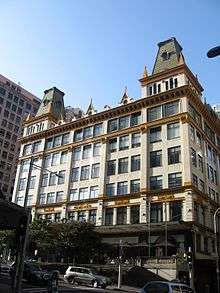Mark Foy's
Mark Foy's Limited or Mark Foy's was a department store in Sydney, New South Wales, Australia, founded by Francis Foy and his brother Mark Foy. The department store was named after their father, Mark Foy (senior) and traded between 1885 and 1980.
 The Mark Foy's building | |
| Mark Foys | |
| public company | |
| Industry | Retail |
| Fate | defunct |
| Founded | Sydney, New South Wales (1885) |
| Founder | Francis Foy, Mark Foy |
| Defunct | 1980 |
| Headquarters | Sydney, New South Wales , Australia |
| Services | Department store |
Trading history
After first establishing their store on Oxford Street in 1885,[1] the Foy brothers opened 'Mark Foy's Piazza Store in 1909 on Liverpool Street. This was a three-storey store (two floors plus basement) designed by architects Arthur McCredie & Arthur Anderson with a turreted mansard roof.[2] The building was partially modelled on the Parisian Le Bon Marche department store. Its piazza, chandeliers, marble and sumptuous ballroom made it a Sydney institution and one of Australia's foremost fashion stores. The store had Australia's first escalator.[1] The store stretched around a whole city block and gave rise to the colloquial saying, when referring to a person of overweening confidence, "You've got more front than Mark Foy's."[3] The store was remodelled in 1927.[2] The store was linked in 1926 to the newly opened Museum Railway Station[4] by underground subway.[5]
The company had their most profitable year in 1954/1955. With the decline of the Liverpool street area in the 1950s and 1960s, Mark Foys began to experience financial decline declaring their first financial loss in 1966/1967.
A store was opened at Rockdale in 1963 in the Southside Plaza (now Rockdale Plaza). The Rockdale store was extensively damaged by fire in 1967.[6] Rebuilt, it became a McDowells store and then was rebranded as Waltons in 1972. In 1964 Mark Foy's opened a store in the Sydney suburb of Eastwood[7] and in 1966 at Burwood in the Burwood Westfield Shopping Town.[8] The Eastwood Store became a McDowells store and then a Waltons.[9] Other stores were opened across Sydney's suburbs at Chatswood,[10] Northbridge, Double Bay and Bankstown.[11]
In 1968 Mark Foy's was taken over by McDowells Holding Ltd.[11] In 1972, McDowells was in turn acquired by Waltons. After Waltons was split in 1987, six stores were sold to George Bloomfield of Australian clothing manufacturer Wraggs. The stores still trading as Mark Foys, were sold again to Clothing retailer Richards in November, 1986.[12]
In 1980, when it ceased trading after going into receivership, the City Piazza building briefly became "Grace Bros Piazza" until 1982. The natural shift of the retailing hub further north of the CBD, around Pitt Street Mall, led to its closure.
The City Piazza building is now used as a complex of state courthouses known as the Downing Centre. However, its former role is preserved in the ornate tilework on the facade and surroundings. The Mark Foy's warehouse is a heritage brownstone building located in nearby Goulburn Street, which has been converted into residential apartments known as Sydney Mansions.
Ice skating rink
An ice skating rink was installed on the fifth floor in the store as part of a Swiss alpine setting for the presentation of skating costumes and evening gowns.[13] The miniature rink opened at lunchtime on 11 April 1950 for the fashion parade titled "Fashion Fantasy On Ice", which would have a duration of 10 days.[14] There was the prospect of customers being able to use the miniature ice rink.[15]
Mark Foys and sectarianism
It is claimed that the Foy family, Irish-born Roman Catholics, would only employ Catholics and stocked uniforms of the major Catholic schools, in an environment when government organisations had a policy to not employ Catholics, and David Jones specialised in Anglican school uniforms.[3]
Other business interests
Mark Foy also founded the Hydro Majestic Hotel at Medlow Bath near Katoomba,[1] and Australia's oldest open boat sailing club, the Sydney Flying Squadron, founded in 1891.
Gallery
- Downing Centre, former Mark Foy's department store, Sydney central business district
- Entrance sign on the building now known as the Downing Centre
- Signs on the side of the building now known as the Downing Centre
- Sydney Mansions, former Mark Foy's warehouse, Surry Hills
References
- Walsh, G. P. (1981). "Foy, Mark (1865–1950)". Australian Dictionary of Biography. National Centre of Biography, Australian National University. Retrieved 24 June 2013.
- http://collection.hht.net.au/firsthhtpictures/picturerecord.jsp?recno=37955
- McInnes, William (2010). The Making of Modern Australia. Hachette Australia. ISBN 978-0-7336-2780-4.
- Museum railway station
- http://sydney-city.blogspot.com.au/2011/05/museum-railway-station-mark-foys.html
- https://www.flickr.com/photos/sydneyneverbuilt/12181767133/
- The Age, 31 July 1962, Page 6
- http://shoppingmallmuseum.blogspot.com.au/2010/06/burwood-westfield-shoppingtown-burwood.html
- Bastians, Kate: Swinging sixties shopping in suburbia: Video shows how much Eastwood has changed NORTHERN DISTRICT TIMES SEPTEMBER 19, 2014 5:25PM
- http://acms.sl.nsw.gov.au/item/itemLarge.aspx?itemID=316723
- http://www.dictionaryofsydney.org/entry/mark_foys
- Richards Buys last Mark Foys Stores, The Sydney Morning Herald, 25 November 1986, Page 28
- "Ice Rink In City Store For "Parade"". The Sydney Morning Herald. 6 April 1950. Retrieved 23 July 2017.
- "Lunchtime Parade of Easter Fashions On Ice". The Sun. 11 April 1954. Retrieved 23 July 2017.
- "Ice Rink In City Store". The Sydney Morning Herald. 16 December 1954. Retrieved 23 July 2017.
External links
- Michael Lech (2011). "Mark Foy's". Dictionary of Sydney. Dictionary of Sydney Trust. Retrieved 10 October 2015.